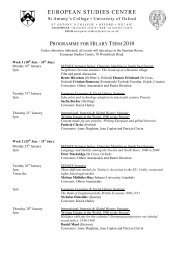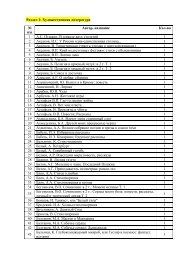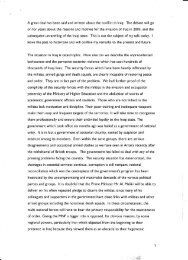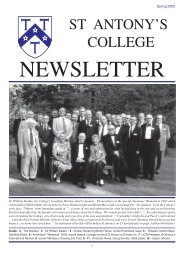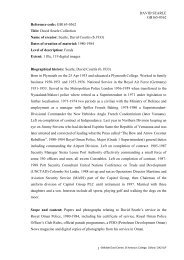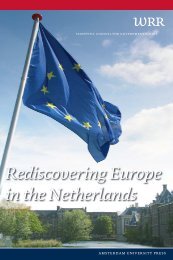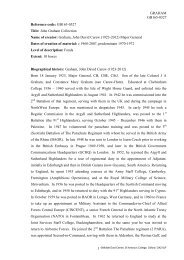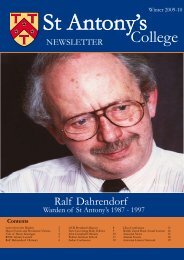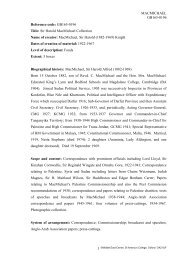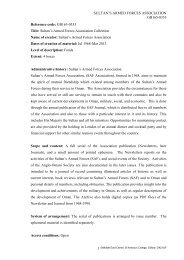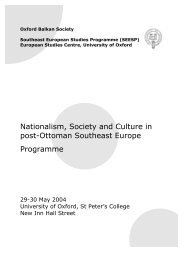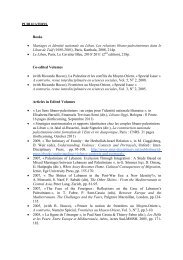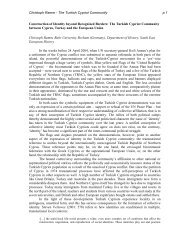The Western Condition - St Antony's College - University of Oxford
The Western Condition - St Antony's College - University of Oxford
The Western Condition - St Antony's College - University of Oxford
You also want an ePaper? Increase the reach of your titles
YUMPU automatically turns print PDFs into web optimized ePapers that Google loves.
<strong>The</strong> <strong>Western</strong> <strong>Condition</strong>: Turkey, the US and the EU in the New Middle East<br />
Brussels. 157 <strong>The</strong> same, <strong>of</strong> course, also applies to Turkey, where contending perceptions <strong>of</strong><br />
Europe reflect the on-going quest for self-identification within this country. This dynamic<br />
presents us with a contradiction: Turkey’s engagement with Europe contains the potential to<br />
become a pr<strong>of</strong>oundly transformative relationship for both sides thanks to this shared domestic<br />
popular element, but that complex element does not always push the two sides towards more<br />
cooperation, openness and liberal democratic reform. In fact, it usually does not.<br />
For a long time, the popular image <strong>of</strong> Turkey in Europe oscillated between on one hand a fear,<br />
awe and wonder inspiring entity and on the other hand a more familiar if uninspiring entity that<br />
is ‘almost but not quite’ European, lingering awkwardly at the continent’s geopolitical, socioeconomic<br />
and intellectual periphery. 158 <strong>The</strong> former category includes essentialising images <strong>of</strong><br />
invading Ottoman armies, pushing deep into the Christian heartland with their military and<br />
moral prowess, conquering Constantinople and laying siege to Vienna; the lavish palaces,<br />
mysterious courts and exotic harems recounted and fantasied by travelling storytellers; and more<br />
recently, the image <strong>of</strong> an assertive, dynamic, yet unmistakably more Islamic country, whose<br />
charismatic leader dares to publicly dress down Israel, which at once excites and unsettles many<br />
European onlookers. In the second category, we come across images <strong>of</strong> the ailing Ottoman<br />
Empire – the sick man <strong>of</strong> Europe – waiting to be dismembered by the French, British and<br />
Russians; French and German inspired military <strong>of</strong>ficers, attempting to construct a strictly<br />
European nation-state; immigrant guest workers arriving en masse to participate in post-WWII<br />
reconstruction and “Wirtschaftswunder” or, to this day, a large and relatively poor country<br />
desperately seeking inclusion in the European Union.<br />
In Turkey, too, contending perceptions <strong>of</strong> Europe have long reflected the continuous quest for<br />
self-identification. While for many Ottoman Muslims, especially during the formative centuries<br />
<strong>of</strong> the empire, Europe beyond its borders constituted the ‘house <strong>of</strong> war’ (dar al-harb), the land <strong>of</strong><br />
unbelievers waiting to be incorporated into the ‘house <strong>of</strong> Islam’ (dar al-Islam), for many others –<br />
Muslims and non-Muslims – it gradually became the prime inspiration for reform and fashion.<br />
This second category included the Ottoman palace, much <strong>of</strong> the urban middle and upper middle<br />
classes, and eventually most <strong>of</strong> the senior <strong>of</strong>ficers in the military, who founded the Turkish<br />
republic in 1923. In the interwar period, the Kemalist leaders <strong>of</strong> the young republic looked to<br />
157 It is probably not too farfetched to speculate that had the ‘Eurocrats’ actually possessed the ability to shape the<br />
public debate on Turkey to the extent that the foreign policy strategists do in the US, Turkish entry into the EU<br />
would have been a far more realistic prospect, as it is the rising grassroots opposition to European expansion and<br />
not so much the political will <strong>of</strong> the EU elites that has stalled this process.<br />
158 In fact, the term ‘Turkey’ was first was used in Europe in reference to the Ottoman Empire. Prior to the<br />
founding <strong>of</strong> the Republic <strong>of</strong> Turkey in 1923, the term meant little or nothing to the inhabitants <strong>of</strong> the geographic<br />
area that the republic comprises today. A corresponding term did not exist in most languages spoken within the<br />
Ottoman borders, including in Ottoman Turkish. For centuries, the Ottoman Empire was known to its subjects as<br />
‘Devlet-i Âliye-yi Osmâniyye’, or the domains <strong>of</strong> the House <strong>of</strong> Osman. It meant little to the Ottomans that this<br />
multi-ethnic and multi-religious empire ruled by a dynasty that almost exclusively married Christian/European<br />
women, and had been engaged in the internal politics and alliance making <strong>of</strong> the continent at least since the 15 th<br />
century, could be seen as a purely Turkish, Muslim or non-European entity.<br />
59



